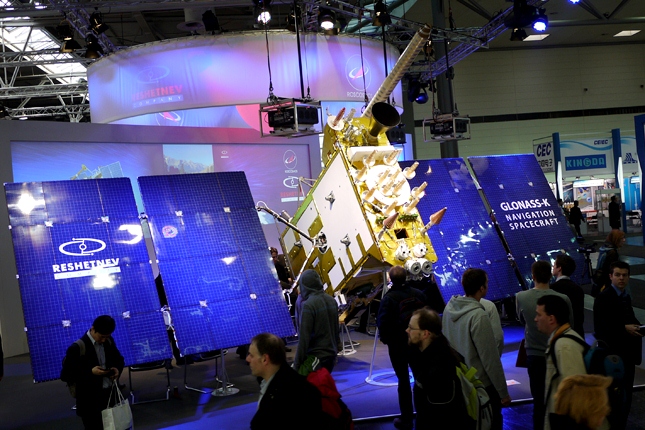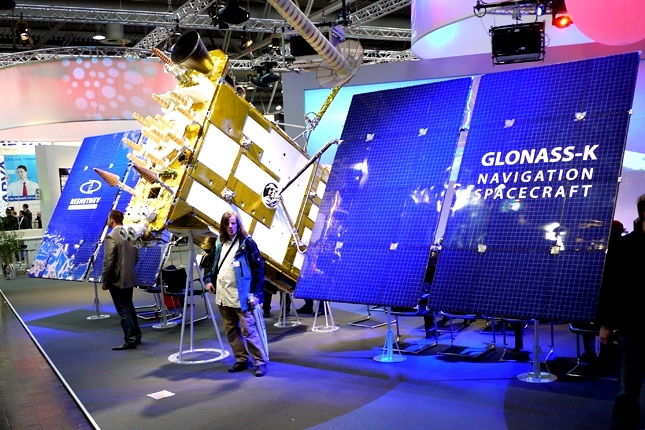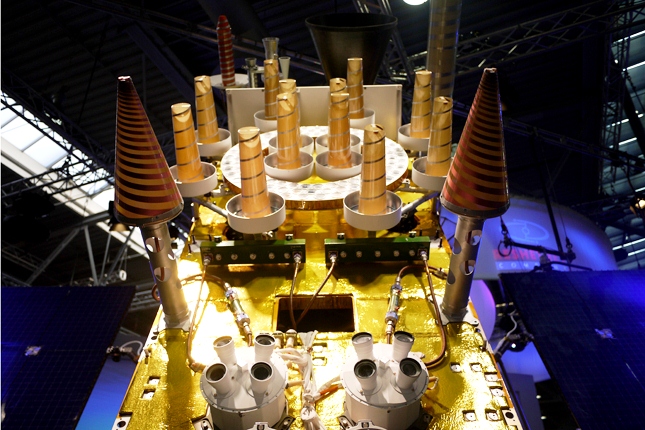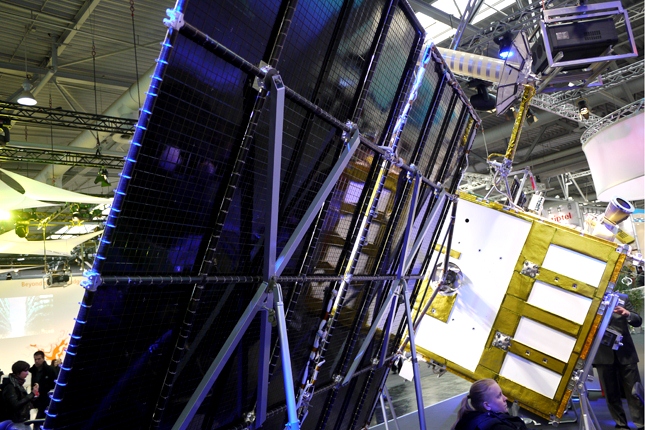Video story about the GLONASS-K satellite
Having rushed at night to the pavilions of the CeBIT 2011 exhibition still under construction, I saw a luxurious piece: the full-size model of the GLONASS-K, a third-generation satellite from the GLONASS series.

The next day I came to an already open stand, spent 30 minutes on persuasion and as a result, a representative of the manufacturing company put on a buttonhole and told me on camera .
')
According to Wikipedia, the first satellite of the Global Navigation Satellite System (GLONASS) was put into orbit on October 12, 1982 (!). Already after 11 years, the system was officially put into operation, with an orbital constellation of 12 satellites. In December 1995, the number of satellites was increased to full-time staff - 24 pieces. By 2001, due to a lack of funding and a short service life of the devices, the number of satellites was reduced to six.
On February 26, 2011, the first GLONASS third-generation satellite, Glonass K1, was launched from the Plesetsk cosmodrome.
GLONASS satellites are not one, but five (in the sense of models, not pieces (though who knows them :)). The model of the device, which was presented at CeBIT 2011 is called "Glonass-K" (code name - "Uragan-K"). It differs from previous models by increased service life up to 10 years, reduced mass and other improvements. It is believed that with the transition to Glonass-K, the accuracy of the Russian system will become comparable with the accuracy of the GPS system.

Mass Glonass-K is 935 kilograms. The most valuable part of the satellite is the so-called payload, with a lot of receiving and transmitting antennas of various ranges, including antenna command-measuring system through which the satellite receives all the necessary commands from the ground and transmits information about its state. In the center of the payload are corner glass laser reflectors (whose presence on the moon is one of the proofs that Americans were there at all) to accurately determine a satellite in orbit with an accuracy of tens of centimeters: a signal is sent to Earth from the satellite, reflected and returned.

The satellite is powered by four highly efficient solar cells based on gallium arsenide - a chemical compound of gallium and arsenic. These batteries are produced at the Moscow enterprise Kvant.

GLONASS uses different control logic and other algorithms than American GPS, but there are no fundamental differences between the operation of the two systems. When working together, the systems can complement each other, greatly increasing the positioning accuracy.

The next day I came to an already open stand, spent 30 minutes on persuasion and as a result, a representative of the manufacturing company put on a buttonhole and told me on camera .
')
According to Wikipedia, the first satellite of the Global Navigation Satellite System (GLONASS) was put into orbit on October 12, 1982 (!). Already after 11 years, the system was officially put into operation, with an orbital constellation of 12 satellites. In December 1995, the number of satellites was increased to full-time staff - 24 pieces. By 2001, due to a lack of funding and a short service life of the devices, the number of satellites was reduced to six.
On February 26, 2011, the first GLONASS third-generation satellite, Glonass K1, was launched from the Plesetsk cosmodrome.
GLONASS satellites are not one, but five (in the sense of models, not pieces (though who knows them :)). The model of the device, which was presented at CeBIT 2011 is called "Glonass-K" (code name - "Uragan-K"). It differs from previous models by increased service life up to 10 years, reduced mass and other improvements. It is believed that with the transition to Glonass-K, the accuracy of the Russian system will become comparable with the accuracy of the GPS system.

Mass Glonass-K is 935 kilograms. The most valuable part of the satellite is the so-called payload, with a lot of receiving and transmitting antennas of various ranges, including antenna command-measuring system through which the satellite receives all the necessary commands from the ground and transmits information about its state. In the center of the payload are corner glass laser reflectors (whose presence on the moon is one of the proofs that Americans were there at all) to accurately determine a satellite in orbit with an accuracy of tens of centimeters: a signal is sent to Earth from the satellite, reflected and returned.

The satellite is powered by four highly efficient solar cells based on gallium arsenide - a chemical compound of gallium and arsenic. These batteries are produced at the Moscow enterprise Kvant.

GLONASS uses different control logic and other algorithms than American GPS, but there are no fundamental differences between the operation of the two systems. When working together, the systems can complement each other, greatly increasing the positioning accuracy.
Source: https://habr.com/ru/post/115761/
All Articles